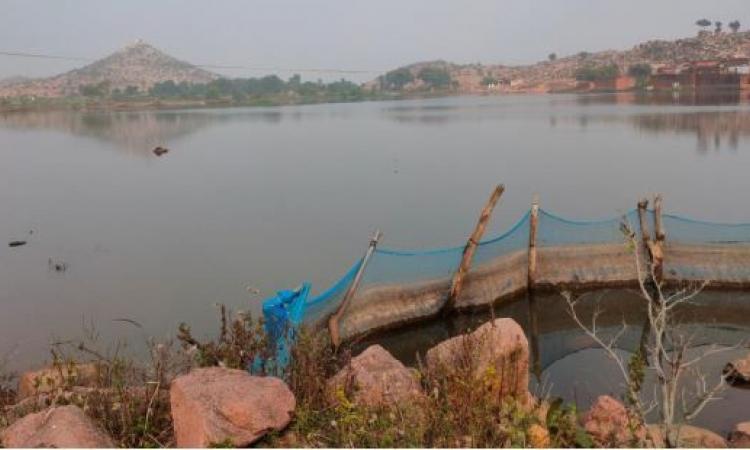
150 years ago, no government system anywhere in the world was responsible for water supply. The community; owned, managed, maintained and controlled the water everywhere (Centre for Science and Environment, 2001). Grand water harvesting structures were built across the country financed by different kingdoms.
The culture of building tanks was widespread in the Bundelkhand region, which was ruled by Chandela and Bundela Kings. 8000 Chandela and Bundela Tanks were built between 800 to 1200 AD (IGG & BIWAL, Baseline Report, 2020). Similarly, Keres were built in Karnataka, Eri tanks were built in Tamil Nadu and Chevuru tanks were built in Andhra Pradesh and Orissa. Bihar had the famous Ahar Pynes to store water and Gond Kings funded huge Katas; three-sided reservoirs, in Gondwana (Agarwal, 1997) comprising Madhya Pradesh, Maharashtra, Orissa and Andhra Pradesh. According to official estimates, there were 15.13 lakh tanks in India in 1986-87.
The arrival of the British brought this magnificent tradition to a standstill by transferring the management of these structures to the government. Post-independence too, little was done to improve the condition and, subsequently, the community got alienated from the structures.
The area under tank irrigation declined drastically post the 1970s when the green revolution coupled with government incentivising use of diesel pump sets led to an era of increased reliance on groundwater sources. Less than 3% of the area was under tank irrigation by 2012-13 compared to 38% in the 1960s (Asian Development Bank, 2006) (MOSPI, 2017).
Due to a vast increase in the number of irrigators, patched landholdings, change in land control, increase in well irrigation in the tank commands, and change in the attitude of farmers, the village-level institutions have undergone a change. The institutions have lost their capacity to mobilise resources for maintenance of tank systems and also since the tanks are viewed as government property, the will to repair them is low among community members.
Tank rehabilitation
Tank rehabilitation makes perfect sense, given the vast potential of tanks to store and harvest rainwater. It is also a much more sustainable way of irrigation compared to resource-intensive well-based irrigation systems. The South Indian states started rehabilitating tanks in the mid-1980s under state-funded programs as well as funding from external agencies. However, most of the state-funded programs focused on physical works rather than on community involvement, which led the tanks to fall back in a vicious cycle of rehabilitation-poor maintenance-deterioration-rehabilitation. (India Resident Mission, 2006).
The Bundelkhand Initiative for Water, Agriculture and Livelihood (BIWAL) led by Self Reliant Initiative for Joint Action (SRIJAN) is a unique amalgamation of civil society, government and funding agencies.
The project execution is being carried out by SRIJAN, Haritika, Bundelkhand Sewa Sansthan, Yuva Koushal Vikash Mandal, Arunodaya, Akhil Bhartiya Samaj Sewa Sansthan and Jal Jivika in different districts of Southern Uttar Pradesh and Northern Madhya Pradesh. The funding support is being provided by the Hindustan Unilever Foundation and convergence funding and support is being provided by the Governments of Madhya Pradesh and Uttar Pradesh.
In the first phase, 54 tanks have been desilted resulting in an excavation of 4.24 lakh cubic meter of silt. This has led to the creation of 42.49 crore litres of water storage potential. Of the 54 tanks desilted, 28 tanks were desilted in Madhya Pradesh and 26 in Uttar Pradesh. Within just a year after the desilting, the multiple-use nature of the tanks has been restored. These revived tanks are now being used for irrigation, fisheries, singhara and makhana cultivation, domestic use and for livestock.
Community involvement has been a notable aspect of BIWAL. A Tank Management Committee (TMC) is formed when the rehabilitation process is initiated to ensure participatory planning of works. The transportation of silt from the tank site to the agricultural fields is undertaken by the community. Decisions regarding hiring tractors for silt transportation, timings and shifts of silt removal, development of norms to ensure equity in silt distribution, etc. are undertaken by the TMCs.
After the rehabilitation and capacity building of the TMC, the tanks are handed over to the community. The village community members form a cooperative society for ease in undertaking livelihood operations such as fishery or irrigation and the TMC acts as the executive body for planning the livelihood uses and formulating norms for water usage.
The strong community ownership of the project is evident from the fact that 68.5% of the total cost of the revival of 54 tanks has been contributed by the community.
An initial survey was undertaken to understand the impact of the rehabilitation works. While the timescale to understand the impact is very less (about a year), the key findings of the study undertaken by the Atal Bihari Vajpayee Institute of Good Governance and Policy Analysis are:
- Initial estimates show a groundwater recharge of 621 TCM or 19.6% of the present storage capacity of water bodies.
- A total of 3923 farmers were directly benefitted due to the provision of irrigation facilities.
- Additional food production of 29,247.79 tonnes due to improved agricultural practices promoted by BIWAL partners, and as a result of silt application.
Given the large number of tanks spread all across the country, the revival of these structures could unleash a stupendous water harvesting potential and reduce the pressure upon groundwater resources. The most important consideration for taking up the revival of tanks is, however, not the revival of the physical structure of the tank but restoring of tank management and control in the hands of local community members.
This case is part of the ‘Compendium of Best Practices: Water Management in Tribal areas’, a document developed by AKRSP(I) and Axis Bank Foundation (ABF).
Author: Anjali Aggarwal is a researcher with seven years of experience in documenting and understanding the change brought by grassroots organizations working in rural parts of India. An alumnus of the Indian Institute of Forest Management, her interest areas are Conservation, Livelihoods, and Education. She likes bird watching and having a dialogue with rural community members.